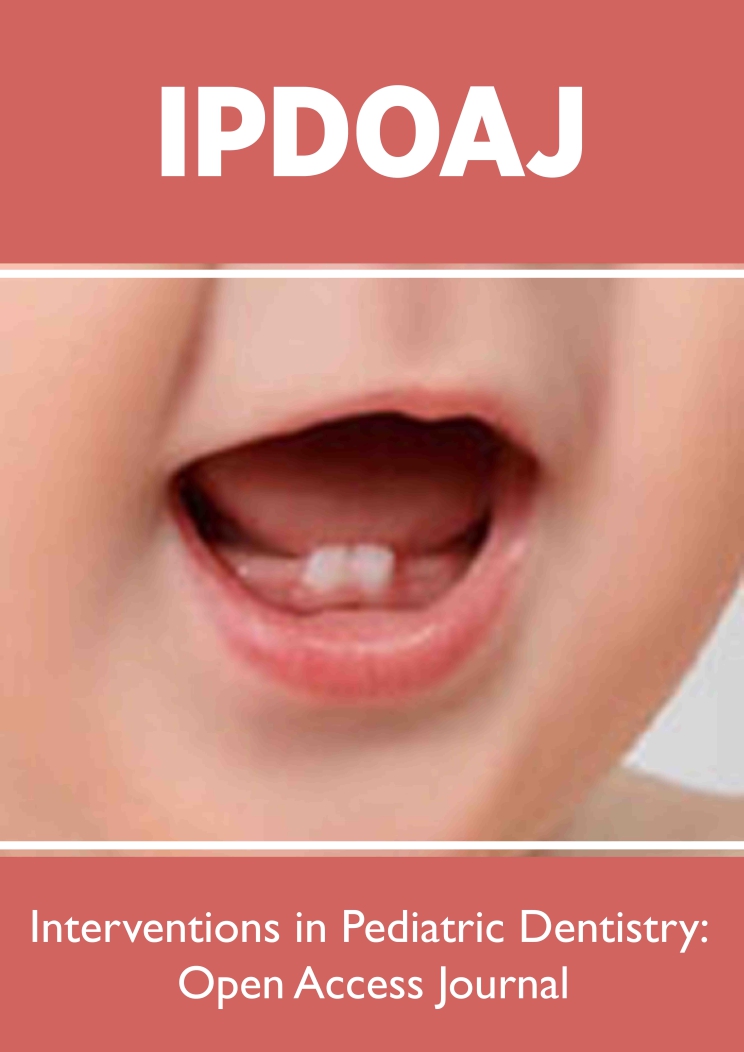
Lupine Publishers Group
Lupine Publishers
Menu
ISSN: 2637-6636
Research Article(ISSN: 2637-6636) 
Oral Health Conditions and Neglect in Child Care: An Integrative Review Volume 8 - Issue 1
Marília Cleide Tenório Gomes de Aguiar, Amanda Caroline Oliveira Henriques Mendes, Maria da Conceição de Barros Correia, José Victor Leal Alves, Assíria Rebeca de Souza Silva, Zilma Ribeiro do Nascimento, Leonardo Cavalcanti Bezerra dos Santos, Rosa Maria Mariz de Melo Sales Marmhoud Coury, Criseuda Maria Benício Barros, Kátia Maria Gonçalves Marques, Valter Romão de Souza Júnior, Niedje Siqueira de Lima and Luciana de Barros Correia Fontes*
- Department of Clinical and Preventive Dentistry, School of Dentistry, Federal University of Pernambuco (UFPE), Brazil
Received: June 26, 2022; Published: July 05, 2023
*Corresponding author: Luciana de Barros Correia Fontes, Department of Clinical and Preventive Dentistry, School of Dentistry, Federal University of Pernambuco (UFPE), Avenida Professor Moraes Rego, 1235, Cidade Universitária, Recife, Pernambuco, Brazil
DOI: 10.32474/IPDOAJ.2023.08.000293
Abstract
The objective of this study was to perform an integrative literature review on whether there is scientific evidence linking children’s oral health conditions with caregiver neglect. An integrative literature review based on the PRISMA method was developed. It was based on a guiding question directly related to the proposed objective, adopting the descriptors in health or MesH terms or alternative terms: “oral health,” “child abuse”, and “children”. The virtual portals PubMed and VHL were considered. The Boolean operators “AND” and “OR” were used in the exploratory search, using the pre-defined inclusion and exclusion criteria. There was a time limit for records between January 2018 and December 2022. Two independent researchers participated directly in the collection, which took place between May and June 2023. From 138 records, six studies were included for qualitative analysis. These showed scientific evidence of worse oral health conditions for children who are victims of neglect, necessitating preventive and control approaches.
Keywords: Oral Health; Children; Child Abuse
Background
The physical, mental and social well-being of children and adolescents represents a major challenge to public health worldwide. This, because of the possible impacts on the growth and development of this target population and the condition of dependence on adult individuals for their assistance, their care. Oral health is considered an integral element of overall health and may impact the functional and psychosocial aspects of individuals [1-3]. When it comes to children, there is a greater dependence on such care, related to the development of cognitive and motor skills and related abilities. The World Health Organization (WHO) defines child maltreatment as “all forms of physical and emotional ill-treatment, sexual abuse, neglect, and exploitation that results in actual or potential harm to the child’s health, development or dignity.” There are four main types of abuse: neglect, physical abuse, psychological abuse, and sexual abuse. Abuse is defined as an act of commission and neglect is defined as an act of omission in the care leading to potential or actual harm. Neglect is the most common form of child abuse which includes, in particular, inadequate health care [4]. The aim of this study is to investigate whether there is scientific evidence linking oral health conditions to neglect of care by caregivers.
Method
Integrative literature review based on the PRISMA or Preferred Reporting Items for Systematic Reviews and Meta-Analyses model [5], with the guiding question: - Is there scientific evidence on children’s oral health conditions and negligence on the part of their guardians or caregivers? The following virtual portals were used for data collection PubMed (United States National Library of Medicine service) and VHL (Virtual Health Library) and their databases. The health descriptors or MeSH Medical Subject Headings term were considered: “oral health”, “child abuse”, and “children” in their Portuguese, Spanish and English versions. Also the advanced search form and with the Boolean operators “AND” and “OR”, through the advanced search form.
Inclusion criteria: all scientific articles published between January 2018 and December 2022 that met the guiding question.
Exclusion criteria: opinions, letters to the editor or other works that were not formally characterized as a scientific article were excluded, as well as repeated studies (where only one was counted) and literature reviews. Also those who did not answer the guiding question.
Two independent reviewers carried out the selection of articles, during the months of May and June in 2023, The articles were included by reading the title and the abstract of the records surveyed, according to the inclusion and exclusion criteria adopted. In the case of repeated records, only one was included. The initial selection was made by reading the title and the abstract. Subsequently, the records were chosen to be read in their entirety and, if included, with the summarized presentation of the main information.
Results
From 138 records, the final sample included fivw studies, presented in the form of a summary table (Figure 1).
Figure 1: Distribution of the selected records according to authorship, year of publication, country, database, objective, study design and sample, objective, main results or conclusions.

Discussion
Dental neglect is the willful failure of parents or guardians to seek and follow through with treatment necessary to ensure a level of oral heath essential for adequate function and freedom from pain and infection [6]. It can be said that inferior health, hygiene, and quality of life conditions were expected for neglected children, which is well documented [7-12] in the selected studies. However, how can the early identification and planning of strategies be carried out in order to establish the child’s well-being in all dimensions that involve his/her growth and development? With many socio-demographic, cultural, and economic variables that need to be considered, it is observed from the selected studies that, amidst a diversity of countries, in terms of characteristics, the problem is recognized and brings negative impacts [7-12]. As for the need for early identification, dental students, the dental surgeon, or the oral health team, in primary care, can be one of the first references in the suspicion of child neglect, particularly when poor oral hygiene occurs and improvement is not observed with positive reinforcement for such and when there is a very large demand for dental treatment, even in early age groups.
Accompanying the situation and seeking the help of the multidisciplinary team, including psychology and social assistance professionals, is unique, so that a positive return can be achieved [13]. The multidisciplinary approach has been utilized extensively by health care professions working with child abuse and neglect families. The multidisciplinary approach has allowed nurses, physicians, social workers, and mental health workers to collaborate in resolving complex problems. Multidisciplinary teams have taken many forms, depending on the demonstrated needs of the clinical setting. The many functions of the team may be summarized as: information-sharing, decision-making, support, and planning. Additional advantages include role clarification and many benefits for patients and families [14,15].
Conclusion
There is scientific evidence between the situation of neglect and the oral health conditions of the child victim. Associations between worse oral conditions, general health, and quality of life have been recorded for children who are victims of neglect. Considering an expected outcome by the context of the topic, there is a need for early identification and supervised interventions over time.
Acknowledgements
There is no conflict of interest or funding support.
References
- Paula JS de, Ambrosano GMB, Mialhe FL (2015) The impact of social determinants on schoolchildren’s oral health in Brazil. Braz Oral Res 29: 1-9.
- Watt R, Sheiham A (1999) Inequalities in oral health: a review of the evidence and recommendations for action. Br Dent Journal 187(1): 6-12.
- Spanemberg JC, Cardoso JA, Slob EMGB, López López J (2019) Quality of life related to oral health and its impact in adults. J Stomatol Oral Maxillofac Surg 120(3): 234-239.
- Gonzalez D, Mirabal AB, McCall JD (2023) Child abuse and neglect. Treasure Island, Stat Pearls Publishing.
- Page MJ, McKenzie JE, Bossuyt PM, Boutron I, Hoffmann TC, et al. (2020) The PRISMA 2020 statement: an updated guideline for reporting systematic reviews. BMJ 372: 71.
- (2022) American Academy of Pediatric Dentistry. Definition of dental neglect. The Reference Manual of Pediatric Dentistry. Chicago, USA.
- Han H, Lees AB, Morse Z, Koziol McLain J (2022) Child abuse knowledge and attitudes among dental and oral health therapists in Aotearoa New Zealand: a cross-sectional study. BMC Health Serv Res 22(1): 1504.
- Aydinoglu S, Arslan I (2021) Are anxiety and the presence of siblings risk factors for dental neglect and oral health status in childrenɁ Arq Pédiatrie 28(2): 123-128.
- Hartung B, Schaper J, Fischer K, Ritz Timme S (2019) Care for children with dental neglect: identification of problems and approaches to solving them. Int J Legal Med 133(2): 641-650.
- Akinkuqbe AA, Hood KB, Brickhouse TH (2019) Exposure to adverse childhood experiences and oral health measures in adulthood: findings from the 2010 Behavioral Risk Factor Surveillance System. JDR Clin Trans Res 4(2): 116-125.
- Kvist T, Annerbäck EM, Dahllöf G (2018) Oral health in children investigated by social services on suspicion of child abuse and neglect. Child Abuse Negl 76: 515-523.
- Silva Júnior IF, Hartwing AD, Stüermer VM, Demarco GT, Goettems ML, et al. (2018) Oral health-related quality of life in Brazilian child abuse victims: a comparative study. Child Abuse Negl 76: 452-458.
- (2022) American Academy of Pediatric Dentistry. Definition of dental neglect. The Reference Manual of Pediatric Dentistry. Chicago, USA.
- Walsh K, Eggins E, Hine L, Mathews B, Kenny MC, et al. (2022) Child protection training for professionals to improve reporting of child abuse and neglect. Cochrane Database Syst Rev 7(7): CD 01175.
- Ludwig S (1981) A multidisciplinary approach to child abuse. Nursing Clinics of North America 16(1): 161-165.
Editorial Manager:
Email:
pediatricdentistry@lupinepublishers.com

Top Editors
-

Mark E Smith
Bio chemistry
University of Texas Medical Branch, USA -

Lawrence A Presley
Department of Criminal Justice
Liberty University, USA -

Thomas W Miller
Department of Psychiatry
University of Kentucky, USA -

Gjumrakch Aliev
Department of Medicine
Gally International Biomedical Research & Consulting LLC, USA -

Christopher Bryant
Department of Urbanisation and Agricultural
Montreal university, USA -

Robert William Frare
Oral & Maxillofacial Pathology
New York University, USA -

Rudolph Modesto Navari
Gastroenterology and Hepatology
University of Alabama, UK -

Andrew Hague
Department of Medicine
Universities of Bradford, UK -

George Gregory Buttigieg
Maltese College of Obstetrics and Gynaecology, Europe -

Chen-Hsiung Yeh
Oncology
Circulogene Theranostics, England -
.png)
Emilio Bucio-Carrillo
Radiation Chemistry
National University of Mexico, USA -
.jpg)
Casey J Grenier
Analytical Chemistry
Wentworth Institute of Technology, USA -
Hany Atalah
Minimally Invasive Surgery
Mercer University school of Medicine, USA -

Abu-Hussein Muhamad
Pediatric Dentistry
University of Athens , Greece

The annual scholar awards from Lupine Publishers honor a selected number Read More...




